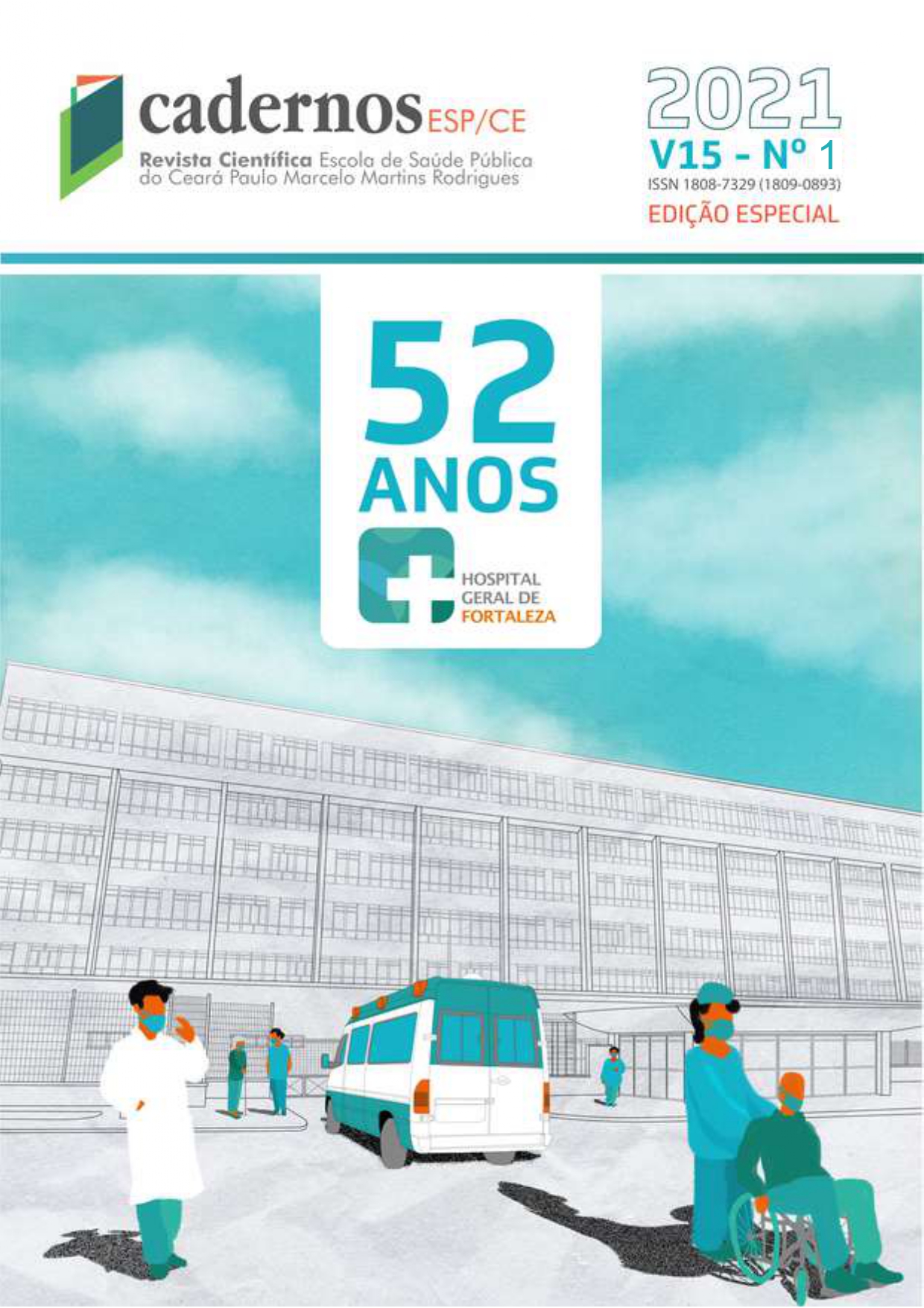EVALUATION OF THE STRUCTURE OF A VAGINAL PESSARY OUTLET
Keywords:
Pelvic Organ Prolapse, Conservative Treatment, Outcome and Process Assessment, Health CareAbstract
Objective: To evaluate the quality of the structure of a specialized outpatient clinic in conservative treatment with vaginal pessaries. Method: An evaluative study was carried out in 2019, at the Vaginal Pessary Outpatient Clinic, of the Hospital Geral de Fortaleza. For the evaluation, it was considered the element structure of the quality, based on the triad proposed by Avery Donabedian (1988): infrastructure, equipment, inputs and human resources. The information was obtained in site visit. The instruments were constructed and adapted from other evaluative studies and according to the research literature. The data were presented descriptively. Results: It was identified that the service has a structure in accordance with the recommended in the research literature, except to the absence of area reserved to the performance of collective educational activities. Outcome: It was evidenced that the second outpatient clinic is in accordance to the recommendations in the research literature, in concern to the elements of physical structure, human resources and inputs. In spite of low variability of the pessary models, available to the insertion, this does not seem to impact the high rates of adhesion and successful insertion.
Downloads
References
2. Abrams P. et al. Incontinence: International Consultation on Incontinence Book. 6th ed. Bristol UK: Internacional Continence Society; 2017.
3. Li Z. et al. An epidemiologic study of pelvic organ prolapse in postmenopausal women: a population-based sample in China. Climacteric. Climacteric: IMS J 2019 Feb;22(1):79-84.
4. Wu JM et al. Prevalence and trends of symptomatic pelvic floor disorders in U.S. women. Obstet. Gynecol. 2014 Jan;123(1):141-148.
5. Bidmead J, Cardozo LD. Pelvic floor changes in the older woman. Br J Urol. 1998 Dec;82 Suppl 1:18-25.
6. de Albuquerque Coelho SC, de Castro EB, Juliato CR. Female pelvic organ prolapse using pessaries: systematic review. Int Urogynecol J. 2016 Dec;27(12):1797-1803.
7. Bezerra LR, Vasconcelos Neto JA, Vasconcelos CT et al. Prevalence of unreported bowel symptoms in women with pelvic floor dysfunction and the impact on their quality of life. Int Urogynecol J. 2014 Jul;25(7):927-33.
8. Robert M, et al. Technical update on pessary use. J Obstet Gynaecol Can. 2013 Jul;35(7):664-674.
9. Abdool, Z. et al. Prospective evaluation of outcome of vaginal pessaries versus surgery in women with symptomatic pelvic organ prolapse. Int Urogynecol J. 2011 Mar;22(3):273-8.
10. Abdulaziz M et al. An integrative review and severity classification of complications related to pessary use in the treatment of female pelvic organ prolapse. Can Urol Assoc J. 2015 May-Jun;9(5-6):E400-6.
11. Dueñas JL, Miceli A. Effectiveness of a continuous-use ring-shaped vaginal pessary without support for advanced pelvic organ prolapse in postmenopausal women. Int Urogynecol J. 2018 Nov;29(11):1629-1636.
12. Lone F et al. A 5-year prospective study of vaginal pessary use for pelvic organ prolapse. Int J Gynaecol Obstet. 2011 Jul;114(1):56-9.
13. Vasconcelos CTM et al. Pessary evaluation for genital prolapse treatment: From acceptance to successful fitting. Neurourol Urodyn. 2020 Nov;39(8):2344-2352.
14. Donabedian A. The quality of care. How can it be assessed? JAMA. 1988 Sep 23-30;260(12):1743-8.
15. Campbell SM, Roland MO, Buetow SA. Defining quality of care. Soc Sci Med. 2000 Dec;51(11):1611-25.
16. Bernardo EBR. Avaliação da assistência pré-natal de gestantes com risco habitual. Fortaleza. Dissertação (Mestrado em Enfermagem) – Programa de Pós-Graduação em Enfermagem, Departamento de Enfermagem, Universidade Federal do Ceará;2016.
17. O'Dell K, Atnip S. Pessary care: follow up and management of complications. Urol Nurs. 2012 May-Jun;32(3):126-36, 145; quiz 137.
18. Conselho Nacional de Saúde (Brasil). Resolução n° 466, de 12 de dezembro de 2012. Aprova normas regulamentadoras de pesquisas envolvendo seres humanos. Brasília: Diário Oficial da União 13 jun 2013; Seção 01.
19. Vasconcelos CTM et al. Disfunções do assoalho pélvico: perfil sóciodemográfico e clínico das usuárias de um ambulatório de uroginecologia. Rev Elet Gest & Saúde 2013;4(1):1484-98.
20. Karbage SA, Santos ZM, Frota MA, de Moura HJ, Vasconcelos CT, Neto JA, Bezerra LR. Quality of life of Brazilian women with urinary incontinence and the impact on their sexual function. Eur J Obstet Gynecol Reprod Biol. 2016 Jun;201:56-60.
21. Vasconcelos Neto JA, Vasconcelos CTM, Regadas SMM, Bezerra LRPS, Lustosa KA, Karbage SAL. Clinical impact of bowel symptoms in women with pelvic floor disorders. Int Urogynecol J. 2017 Sep;28(9):1415-1420.
22. Ferreira HLOC et al. Protocol for pelvic organ prolapse treatment with vaginal pessaries. Acta paul. enferm. 2018 Dec ; 31( 6 ): 585-592. Avaible from:http://www.scielo.br/scielo.php?script=sci_arttext&pid=S0103-21002018000600585&lng=en.
23. Pott-Grinstein E, Newcomer JR. Gynecologists' patterns of prescribing pessaries. J Reprod Med. 2001 Mar;46(3):205-8.
24. Wolff B, Williams K, Winkler A, Lind L, Shalom D. Pessary types and discontinuation rates in patients with advanced pelvic organ prolapse. Int Urogynecol J. 2017 Jul;28(7):993-997.
25. Anger JT et al. Quality-of-care indicators for pelvic organ prolapse: development of an infrastructure for quality assessment. Int Urogynecol J. 2013 Dec;24(12):2039-47.
26. Alas AN et al. Measuring the quality of care provided to women with pelvic organ prolapse. Am J Obstet Gynecol. 2015 Apr;212(4):471.e1-9.
27. Brown LK et al. Defining Patient Knowledge and Perceptions of Vaginal Pessaries for Prolapse and Incontinence. Female Pelvic Med Reconstr Surg. 2016 Mar-Apr;22(2):93-7.
28. Bugge C, Hagen S, Thakar R. Vaginal pessaries for pelvic organ prolapse and urinary incontinence: a multiprofessional survey of practice. Int Urogynecol J. 2013 Jun;24(6):1017-24.
29. Tso C, et al. Nonsurgical Treatment Options for Women With Pelvic Organ Prolapse. Nurs Womens Health. 2018 Jun;22(3):228-239.
30. Silva MZO, Mota GF. Atuação da equipe de enfermagem na prevenção de doenças crônicas. Cadernos ESP-Revista Científica da Escola de Saúde Pública do Ceará. 2011; 5(2):55-67.
Downloads
Published
How to Cite
Conference Proceedings Volume
Section
Categories
License
Copyright (c) 2021 Cadernos ESP

This work is licensed under a Creative Commons Attribution 4.0 International License.
Accepted 2021-05-31
Published 2021-07-27























